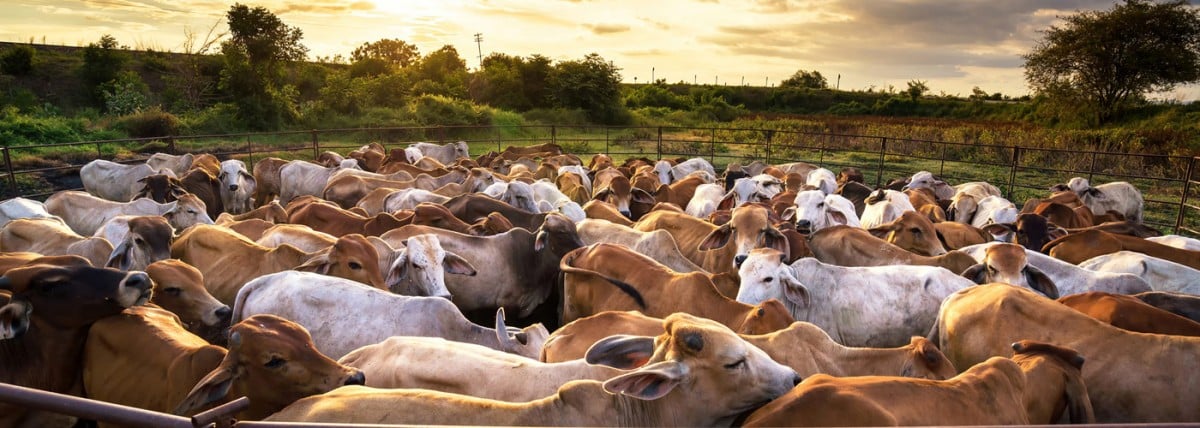RethinkX predicts transformation of meat industry within decades

Could the U.S. cattle industry be transformed sooner than expected? A new report by the economic think tank RethinkX suggests that novel food production methods that rely on fermentation and plant-based ingredients could capture market share much more quickly than mainstream analysts anticipate.
The authors write, ” The impact of this disruption on industrial animal farming will be profound. By 2030, the number of cows in the U.S. will have fallen by 50% and the cattle farming industry will be all but bankrupt. All other livestock industries will suffer a similar fate….”
There are many factors that could argue against the timeline suggested in the report, such as the necessity of a massive new production infrastructure, questions of consumer acceptance, and political support for incumbent industries. However, RethinkX’s analyses of our current cattle industry reveal some interesting potential feedback mechanisms that everyone from industry to investors should consider.
Fermentation is already common
The report focuses predominantly on a technology development they refer to as “precision fermentation,” which they define as using a microorganism to produce a specific desired molecule. This process is already routinely used in the food industry to make molecules ranging from proteins (for example, enzymes like rennet for cheese production) to vitamins (nearly all citric acid, or Vitamin C, is made by fermentation) to lipids like algal-derived omega-3 fatty acids used in supplements and plant-based seafood products.
It remains to be seen what price point is ultimately achievable for purified ingredients derived from microbial fermentation, though $10/kg is an oft-quoted target. This price point has already been demonstrated for certain enzymes produced at large scale — such as for the bioethanol industry — but may prove more challenging for some of the complex structural proteins that provide functionality in food and biomaterials.
Companies like Geltor have already made substantial progress in cost and scale despite working with large, complex proteins like collagen. Geltor began selling microbially-derived animal collagen to the cosmetics market within four years of being founded, and they plan to launch into the food ingredients sector in 2020.
Fermentation for food ingredients could be even simpler
It should also be noted that for certain food applications, it’s not strictly necessary to purify the protein or ingredient of interest from the microbial biomass as a whole. Therapeutics or enzymes require high purity in order to function properly, and separating those proteins from their microbial host, or “production factory,” accounts for a sizable fraction of their production cost. By contrast, using fermentation to produce food ingredients allows for edible host strains to be used and directly incorporated into the food product.
There has already been a recent surge of interest in expanding our utilization of microbial protein sources. While Quorn was the only company in this sector for decades, we have now seen companies like Prime Roots, Sustainable Bioproducts, Emergy, and Atlast emerge. The edible fungal strains these companies are working with could be used as the starting point for “precision fermentation,” resulting in a product that requires little or no purification.
Notably, the market dynamics the report describes don’t rest entirely upon achieving the bottom-of-the-barrel costs that RethinkX ultimately anticipates the fermentation industry will reach. Three key take-aways from the report are salient regardless of the specific dollar value of these new ingredients or the precise year at which their anticipated tipping points occur:
- From a sensory or functionality perspective, fermentation enables the production of ingredients that can perform better than their conventional animal counterparts, and thus will penetrate the market even before price parity is reached. Again, gelatin provides a useful example here: collagen proteins from different species can be fine-tuned for their gel strength, melt temperature, solubility, stability, and so forth to develop a product that provides the precise desired properties for a given food application. The focus will be on improving quality and performance rather than simply mimicking the properties of the animal-derived counterpart
- Fermentation-derived ingredients or enzymes can enable or enhance the utilization of other non-animal-derived raw materials, hastening the cost curve progression of both plant-based meat and cultivated meat. For example, microbial enzymes are currently used to improve the functionality of plant proteins, and Impossible Foods adds microbially-derived heme protein to their burger to improve the flavor. Likewise, fermentation is already used to produce animal-free growth factors for supporting cultivated meat production. We have just scratched the surface of what’s possible on this frontier. Thus, even if the bulk of the material going into a food product is derived from plants or animal cells, flavorings or enzymes from fermentation can facilitate a substantial improvement in the quality of the final product and reduce production costs.
- Once alternatives for a given animal product achieve meaningful market penetration, a feed-forward loop will trigger accelerated displacement of all other products derived from that species. This is due to the market vulnerabilities associated with the so-called “carcass balancing problem” : throughout the emergence of the cattle industry over thousands of years, various industries have arisen to make use of the sidestreams generated from meat and dairy production (hides, bones, connective tissue, acid whey, etc.) in accordance with the availability of these materials. However, once a better-performing and/or less expensive alternative is available for any of these sidestreams, all of the other sidestreams will become more expensive to compensate for the diminishing by-product market. Thus, one-to-one displacement of all products derived from the cattle industry is not necessary to catalyze this transition. The tipping point for a transition toward non-animal-derived foods, ingredients, and materials will occur sooner than generally expected because the current economics of the industry necessitate value-creation from every part of the animal.
There is precedent for significant change
While the RethinkX report makes some bold predictions, similarly accelerated transitions are not without precedent in the U.S. agricultural system. Large-scale transformations of the food — and even the meat — industry have already occurred in the blink of an eye: for instance, the move from small-scale farms to consolidated industrialized animal farming happened within a single generation because of the massive efficiency gains of the new system despite its externalized costs.
However, this transition is far from inevitable. Scaling and market penetration in the agriculture industry don’t happen overnight in the same way as new electronics or healthcare technologies, if for no other reason than the massive size of the industry and the need for substantial physical infrastructure to produce the required volumes of product throughout the value chain. Governments, investors, and forward-thinking industry leaders would do well to consider the possibility that the timelines presented in this report may not be all that far off of reality — and to identify opportunities that will be created by a transition toward a more efficient and sustainable food system.

